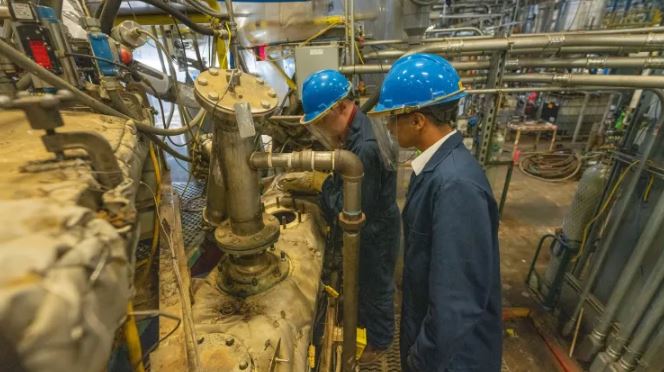UMaine receives $10 million to research turning wood products into jet fuel … and fish food
[Aug 5, 2024]

Travis Glatter and Ehsan Sardar working in July at the Technology Research Center in Old Town, one of the University of Maine Forest Bioproducts Research Institute’s facilities. Photo courtesy of University of Maine
The university has been investigating how to efficiently convert wood chips and other low-value forest products into sustainable jet fuel and cost-effective fish feed.
The University of Maine’s forest bioproducts and aquaculture research institutes have been awarded $10 million from the U.S. Department of Agriculture to continue studying the effectiveness of turning low-value wood into jet fuel and fish food.
The project is a collaboration with the University of Massachusetts-Lowell, the USDA Agriculture Research Service, and Arbiom, a company based in North Carolina and France that makes sustainable protein ingredients for animal food.
It’s the latest effort to find sustainable uses for the state’s abundant forest products.
Travis Glatter and Ehsan Sardar working in July at the Technology Research Center in Old Town, one of the University of Maine Forest Bioproducts Research Institute’s facilities. Photo courtesy of University of Maine
This UMaine project is one of the seven sustainable agriculture projects, totaling $70 million, that the USDA’s National Institute of Food and Agriculture announced in June.
Clayton Wheeler, director of the forest bioproducts research institute, said proposals for the grant funds were submitted over the past three years as the project evolved, and that the university received the award on March 1. The project had its first kickoff meeting in early June, he said.
The goal is to use “low-quality” wood that is left behind in Maine’s forests, like branches and small-diameter trees, and break down elements to use for both aviation fuel and fish feed.
Wheeler said that in forestry, the most valuable wood is used for lumber, some is used for pulp and paper manufacturing, but smaller-diameter trees are “often removed in order to enhance growth.”
Those trees are typically chipped up for biomass or left on the forest floor, he said.
“Rather than burning those materials in a biomass boiler for electricity, or leaving them in the forest, we will be converting those lower-value materials to fuel and fish feed,” he said.
The wood contains lignins – organic compounds that can be converted into fuel – and sugars that can be fermented into proteins for fish feed.
There has been a push in the aquaculture and aviation industries for sustainable alternatives to feed and fuel, respectively.
“There are alternative jet fuels, but not necessarily all of them are renewable or sustainable,” Wheeler said. “(Aviation) is the one transportation sector that cannot be satisfied using renewable electricity. We’re always going to be needing high-density liquid fuels for our aircrafts.”
The National Oceanic and Atmospheric Administration created its alternative feeds initiative to advocate for the lowering of fish oils and fishmeal used in aquaculture feed, and to find more sustainable ways to feed fish without compromising the human health benefits of the farmed fish.
Sampath Gunukula, a UMaine professor and one of the project investigators for the grant, said the research has two major objectives: To develop efficient technology that can convert wood chips to fuel and fish feed; and to do growth studies on how Atlantic salmon are affected by this new fish feed.
In particular, Gunukula said that there are ways to convert wood chips to sugars for feed, but “converting the wood chips into sugars is an expensive process and currently not compatible or not commercially viable.” Instead, Gunukula said the project is attempting to develop a technology that can produce the sugars from wood chips at around 40 cents per kilo.
After the forestry bioproducts institute separates the sugars from the wood chips, the sugars are sent to industrial partner Arbiom to ferment them into protein for the fish feed produced by the USDA. The process is more economical, Wheeler said, because the byproducts of the sugar production are what are used during fuel production.
“One of the issues with making fuels is that there are some byproducts in the wood that can’t effectively be made into fuel and could be used for other purposes, and in this case, the idea is to make fish feed,” Wheeler said. “We’re basically combining tools and skillsets at the university to enhance the use of the state’s wood resources and also contributing to the state’s aquaculture industry.”
Gunukula said the project also has goals of incorporating the project’s findings into course modules at UMaine, and through the UMaine Cooperative Extension.
Source: UMaine receives $10 million to research turning wood products into jet fuel … and fish food